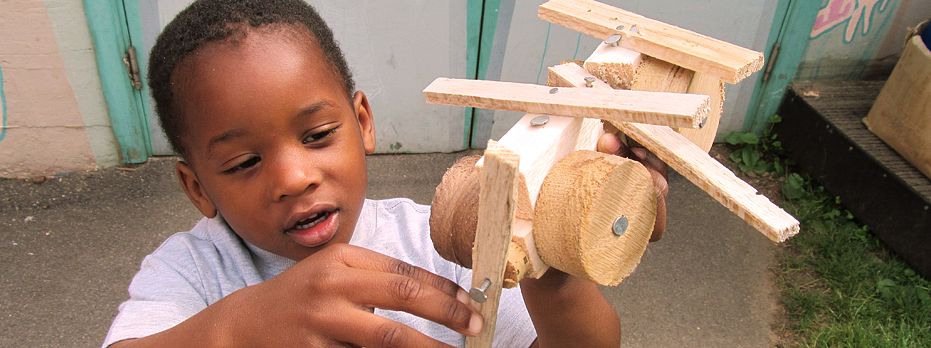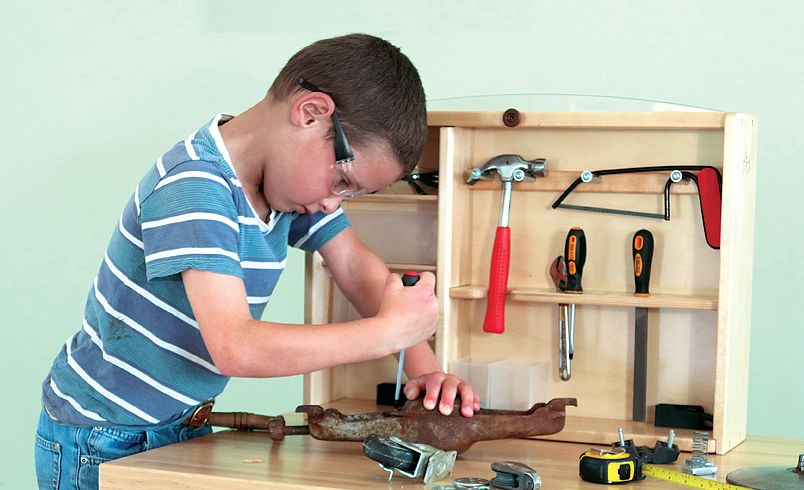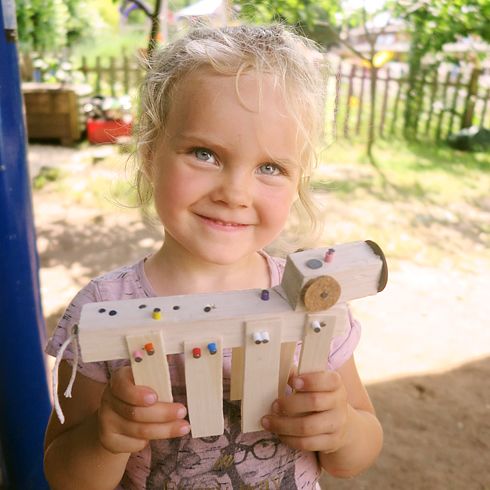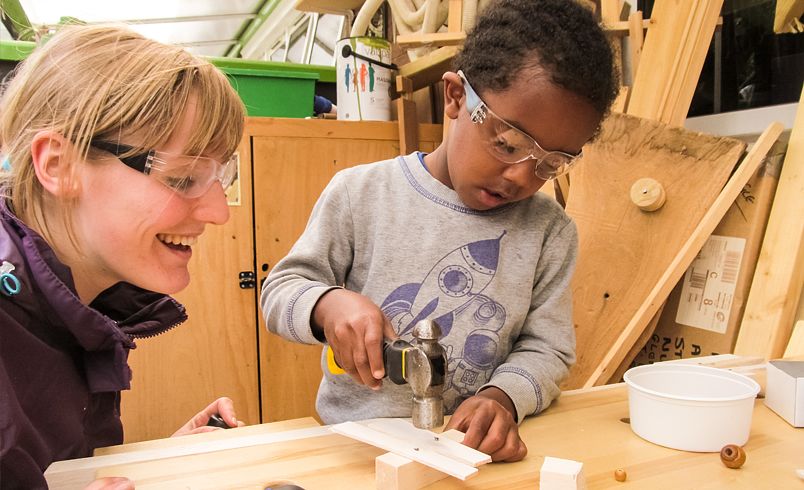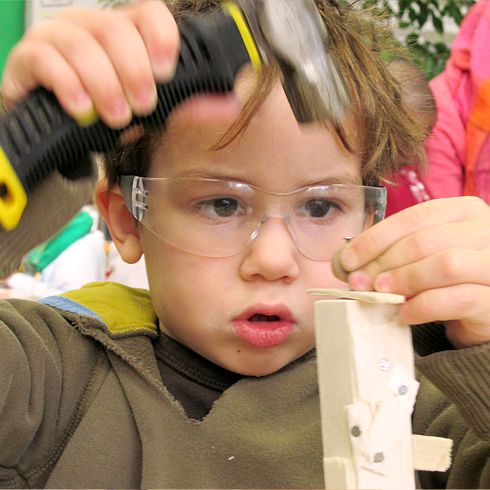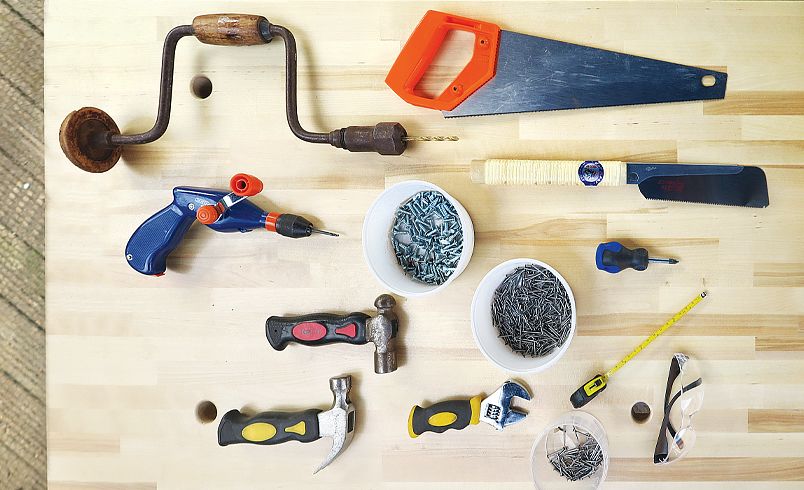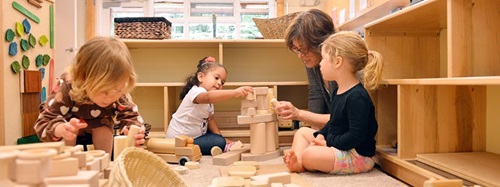Irresistible Learning:
Woodwork in Early Childhood Education
| June 2018Anyone who has witnessed young children tinkering away with tools in the woodworking area will know just how magical it can be. While absorbed in constructing, children display extraordinary levels of concentration and engagement. Encompassing many aspects of curriculum, the benefits of woodwork for children's development are evident across all areas of learning.
The Return of Woodwork
Once almost eradicated due to fears of litigation, woodwork is now making a comeback in early childhood. This indicates a more balanced attitude towards risk and the growing view that health and safety measures are there to help children do activities safely, not deny opportunity. It is important for young children to experience risk in a controlled environment, promoting the development of self-management and decision-making skills.
The renewed interest in woodworking is also a reaction to our increasingly digital world. We are seeing a new generation of children who learn to “swipe” before they can walk. Children are surrounded by complex technology but this has limited their experience of basic technology. Many children today may never have the chance to use simple tools during their entire education.
Woodwork can be seen as a wonderful alternative, engaging children with real tools and authentic materials. Woodwork also provides children with an experience of making and repairing as opposed to our prevailing culture of consuming and disposing. Globally there has been an upsurge in “making” as is evidenced in the rise of the “maker” movement. Makerspaces and tinkering studios are appearing in cities all over the world, providing spaces where children can be curious, inventive, and develop their creative and critical thinking skills.
Learning and Development
There is something really special about woodwork. It is so different from other activities. The smell and feel of wood, the sounds of hammering and sawing, the use of strength and coordination, all go together to captivate young children’s interest. Visiting teachers, observing the woodworking area, always notice the children’s deep levels of concentration and engagement, and are surprised to find the same children still working on their creations an hour or two later. They observe children working with their hands, constructing models, and working on projects, but in fact the real transformation is inside the child—personal development is at the heart of woodwork.
Woodwork is a powerful medium for building self-esteem. Children feel empowered and valued by being trusted to work with real tools. They show satisfaction in their mastery of new skills and take immense pride in their creations. This sense of empowerment and achievement provides a visible boost to their self-confidence.
With woodworking, children develop at their own pace and find their own challenges. Once they have mastered basic skills, they move into open-ended exploration—tinkering, discovering possibilities, and then making unique creations. Because children follow their interests, making what they want to make, they have the intrinsic motivation to persevere to resolve problems and learn from mistakes. Their imagination, creative thinking, and problem-solving skills really flourish as they meet and conquer new challenges.
It is extraordinary to see just how much learning is involved in a woodworking session. It encompasses all areas of development, fostering confident, creative children with a passion for life-long learning. Woodworking incorporates mathematical thinking, scientific investigation, developing knowledge of technology, a deepening understanding of the world, as well as physical development and coordination, communication and language, and personal and social development.
Essentially, woodwork is a ‘win-win’ experience: children greatly enjoy it and remain engaged for extended periods of time and it provides a rich multitude of learning and development. The experience of woodworking—involving hands-on, three-dimensional activity—can be the key that unlocks some children’s learning.
Keeping it Safe
Some teachers and parents are surprised that we introduce woodwork to children as young as three, but it must be emphasised that it is a low risk activity when introduced and monitored correctly. We have been successfully woodworking with preschool children for many years. If we believe young children are old enough to do woodwork then they are also old enough to learn about looking after and taking responsibility for their bodies with appropriate safety protection.
Some of the most important health and safety guidelines:
- Safety glasses should be worn at all times. With hammering, there is a very small risk that a nail could rebound toward the eye or an item being hammered may shatter. Wearing safety glasses eliminates this risk. Small-sized junior safety glasses are now readily available that fit comfortably on even the smallest of heads.
- Ensure all children are given proper instruction on the correct use of all tools. Draw attention to sharp edges and points of tools. Keep a checklist of who has learned to use which tool to ensure all children get correct instruction. Remind children woodwork equipment remains in the woodwork area.
- A good sturdy workbench with a vice is essential to hold wood securely for sawing and drilling.
- Sawing should be monitored with a 1:1 ratio (adult to child). Wood must always be clamped tightly in a vice when being sawn. Ensure that no children are passing in front of the sawing area while another child is sawing. After use, immediately place saw out of reach (but visible to children).
- Check wood for splinters. Avoid very rough, splintery wood. Sand edges after sawing if rough. Caution: Splinters can be a source of blood poisoning. First aid guidance varies so check your local guidelines – common sense would suggest if the splinter is protruding to remove it. Either way parents should be informed of splinters so the splinter site can be monitored for possible infection.
- Ensure all nails and screws are picked up from the floor afterwards. A large magnet can work for this and there will be no shortage of volunteers!
Complete health and safety guidance is covered in the new book Learning Through Woodwork.
It is important that we keep our standards of good practice high so that we may continue to keep woodwork safe and provide these rich learning opportunities for all our children. It does take some effort establishing woodwork, gathering tools and resources but when you see the children’s enthusiasm, exceptional levels of focus and engagement, and the enjoyment and pride in their work it makes all the investment seem worthwhile.
“Woodwork is not about what children make – it’s about the changes that are made within the child” Pete Moorhouse
Recommended toolsHaving the most suitable tools makes a big difference and can reduce risk. The four main woodworking tools are:Hammer: The best hammer is a “stubby” ball-pein hammer. These are now readily available. They are designed for adults to hammer in awkward places but they are a perfect weight for young children. They have short handles so are more controllable and have a large hitting surface making it easier to hammer the nail. Saw:Saws that cut on the pull stroke are so much easier for young children, being more controllable and requiring less effort. There are many pull saws available these days. I am a huge advocate of Japanese pull saws - these are light, have thin blades, and everyone who uses them is taken aback but how easy they are to use. These are used with both hands holding the handle. Hand-drill:The best hand drills are those with enclosed mechanisms as there is no chance fingers can get caught in the exposed cogs. Ensure work is clamped when drilling. Short drill-bits are less likely to snap. Screwdriver:Use a stubby Pozidriv screwdriver. Short-handled screwdrivers are easier to control and the Pozidriv “cross” shape means the screwdriver is less likely to slip out from the screw. Full details of recommended equipment can be found at: http://irresistible-learning.co.uk/resources/ |

